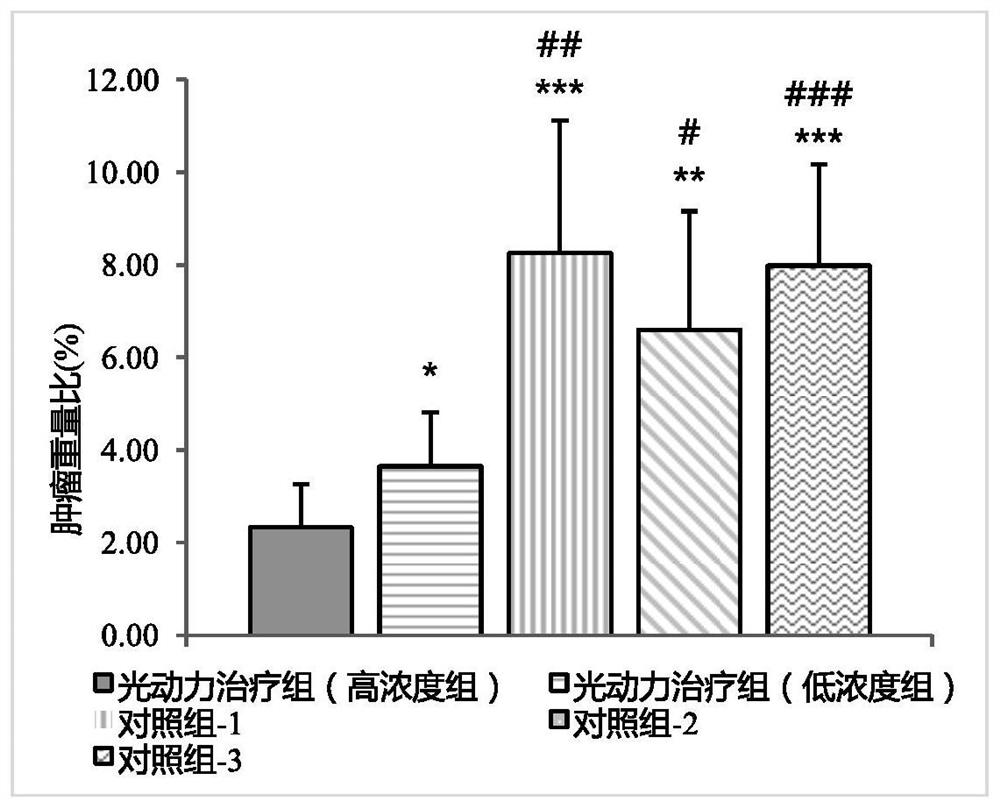Application of diketone compound in photodynamic therapy or diagnosis
A technology for compounds and uses, applied in the field of medicine, can solve problems such as limited application and reduced photochemical efficiency
- Summary
- Abstract
- Description
- Claims
- Application Information
AI Technical Summary
Problems solved by technology
Method used
Image
Examples
experiment example 1
[0126] Experimental Example 1. Evaluation of Compound Toxicity to Tumor Cells
[0127] In this experimental example, the toxicity of the compound to tumor cells was detected by the MTT method. The specific steps are as follows:
[0128] (1) Collect the logarithmic phase cells, adjust the concentration of the cell suspension, add 100 μL to each well, and plate to adjust the density of the cells to be tested to 1000-10000 wells (the edge wells are filled with sterile PBS).
[0129] (2) 5%CO 2 and incubate at 37°C until the cell monolayer covers the bottom of the well (96-well flat-bottom plate), and then add the drug in a gradient concentration. Generally, there are 5-7 gradients, 100 μL per well, and 3-5 duplicate wells.
[0130] (3) The cells were randomly divided into light-administered and dark-administered groups, and 5% CO 2 , incubate at 37°C for 16-48 hours, and observe under an inverted microscope.
[0131] (4) Laser with a wavelength of 450nm-480nm (illumination in...
experiment example 2
[0144] Experimental example 2. Evaluation of the inhibitory effect of compounds on bacteria
[0145] A single colony of E. coli was transferred from a solid Luria Bertani (LB) agar plate to 5 ml of liquid LB medium and incubated at 37°C for 12 hours. Bacteria were collected by centrifugation (7000 rpm, 1 min) and washed three times with PBS buffer. Discard the supernatant and resuspend the remaining E. coli in PBS buffer. Adjust the optical density (OD600) of the bacterial suspension to 1.0. The suspension was then diluted (5-fold) with PBS buffer. Incubate the diluted E. coli cell suspension with a photosensitizer (diketone compound) solution at a concentration of 60 mM for 15 minutes at 37°C in the dark, and then at 15 mW / cm 2 Illuminate under laser light for 200s (wavelength 450nm-480nm, final light intensity 3J cm -2 ), the bacterial suspension after illumination was serially diluted with PBS buffer (10 4 times). Disperse 100 µL of the diluted bacterium E. coli on a ...
experiment example 3
[0149] Experimental example 3. Evaluation of compound's inhibitory effect on tumor (animal experiment)
[0150] 1. Using BJMU-204 as a photosensitizer, BALB / C mice were used to conduct photodynamic therapy tumor effect experiments.
[0151] Modeling method: BALB / C mice were divided into 5 groups, with 11-12 mice in each group. Resuscitate and subculture 4T1 (mouse breast cancer cells) until the cells are in a good state, and are used for tumor formation inoculation. BALB / C mice were depilated and sterilized locally, and tumor cells were injected into the mouse mammary gland fat pad in situ. Tumors formed in 7-10 days.
[0152] Dosing time: Drug intervention was given after the mice became tumors, and intratumoral injections were administered on the next day for photodynamic therapy (laser wavelength 450nm-480nm, light intensity 200mW / cm 2 ).
[0153] Administration method: see the table below, the photosensitizer was dissolved in normal saline, and the mice in groups 1-3 w...
PUM
| Property | Measurement | Unit |
|---|---|---|
| wavelength | aaaaa | aaaaa |
| wavelength | aaaaa | aaaaa |
Abstract
Description
Claims
Application Information
 Login to View More
Login to View More - R&D
- Intellectual Property
- Life Sciences
- Materials
- Tech Scout
- Unparalleled Data Quality
- Higher Quality Content
- 60% Fewer Hallucinations
Browse by: Latest US Patents, China's latest patents, Technical Efficacy Thesaurus, Application Domain, Technology Topic, Popular Technical Reports.
© 2025 PatSnap. All rights reserved.Legal|Privacy policy|Modern Slavery Act Transparency Statement|Sitemap|About US| Contact US: help@patsnap.com



